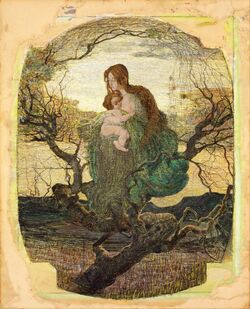Mosaic gold
Topic: Chemistry
 From HandWiki - Reading time: 2 min
From HandWiki - Reading time: 2 min
Mosaic gold or bronze powder refers to tin(IV) sulfide[1] as used as a pigment in bronzing and gilding wood and metal work. It is obtained as a yellow scaly crystalline powder. The alchemists referred to it as aurum musivum, or aurum mosaicum.[2] The term mosaic gold has also been used to refer to ormolu[3] and to cut shapes of gold leaf, some darkened for contrast, arranged as a mosaic.[4] The term bronze powder may also refer to powdered bronze alloy.
Mosaic gold appeared in Europe after the 14th century.[5] Alchemists prepared it by combining mercury, tin, sal ammoniac, and sublimated sulfur (fleur de soufre), grinding, mixing, then setting them for three hours in a sand heat. The dirty sublimate being taken off, aurum mosaicum was found at the bottom of the matrass.
In the past it was used for medical purposes in most chronic and nervous ailments, and particularly convulsions of children;[6] however, it is no longer recommended for any medical uses.[citation needed]
See also
References
- ↑ Holleman, A. F.; Wiberg, E. (2001). Inorganic Chemistry. San Diego: Academic Press. ISBN 0-12-352651-5.
- ↑ "Mosaic". Webster's Revised Unabridged Dictionary (1913). The ARTFL Project. pp. 946. http://machaut.uchicago.edu/?action=search&resource=Webster%27s&page=946&quicksearch=on. Retrieved 5 February 2014.
- ↑ "Ormolu". Webster's Revised Unabridged Dictionary (1913). The ARTFL Project. pp. 1013. http://machaut.uchicago.edu/?action=search&resource=Webster%27s&word=Ormolu&quicksearch=on. Retrieved 5 February 2014.
- ↑
 Chambers, Ephraim, ed (1728). "Gold". Cyclopædia, or an Universal Dictionary of Arts and Sciences (first ed.). James and John Knapton, et al.
Chambers, Ephraim, ed (1728). "Gold". Cyclopædia, or an Universal Dictionary of Arts and Sciences (first ed.). James and John Knapton, et al.
- ↑ Thompson, Daniel V. (2012-05-11) (in en). The Materials and Techniques of Medieval Painting. Courier Corporation. ISBN 978-0-486-14203-6. https://books.google.com/books?id=MU68AQAAQBAJ&dq=mosaic+gold&pg=PA181.
- ↑ "Cyclopædia, or, an universal dictionary of arts and sciences - Full View - UWDC - UW-Madison Libraries". Cyclopædia, or, An universal dictionary of arts and sciences. 1728. https://search.library.wisc.edu/digital/A4C5AV6Q7LZ5DY8E/full/AJYML74YKNB7FH9A. "AURUM Mosaicum is also a Preparation in Pharmacy, thus called from its golden Colour and Appearance. It is made of Mercury, Tin, Sal Armoniac, and Flowers of Sulphur, by grinding, mixing, then setting them three Hours in a Sand Heat.—The dirty Sublimate being taken off, the Aurum Mosaicum is found at the Bottom of the Mattrass. It is recommended in most chronical and nervous Cases; and particularly Convulsions of Children.". [1]
 This article incorporates text from a publication now in the public domain: Chambers, Ephraim, ed (1728). "Mosaic gold". Cyclopædia, or an Universal Dictionary of Arts and Sciences (first ed.). James and John Knapton, et al.
This article incorporates text from a publication now in the public domain: Chambers, Ephraim, ed (1728). "Mosaic gold". Cyclopædia, or an Universal Dictionary of Arts and Sciences (first ed.). James and John Knapton, et al.
 |
 KSF
KSF
